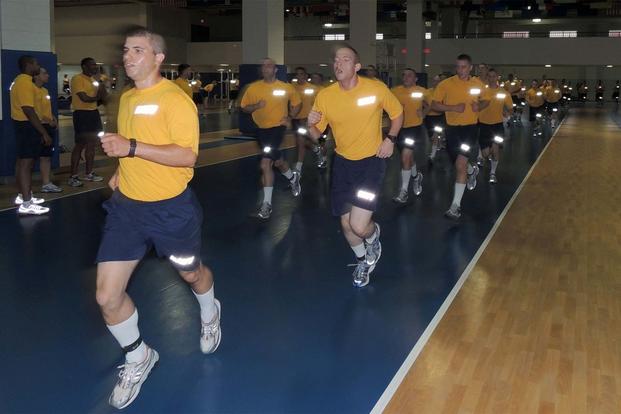Changes at the Navy's enlisted boot camp, including stiffer physical requirements, are producing strong, fit sailors able to tackle the demands of a Great Power competition, according to Master Chief Petty Officer of the Navy Russell Smith.
In the past three years, the Navy has overhauled the physical requirements of enlisted boot camp at Recruit Training Command Great Lakes, Illinois, requiring those joining the service to meet stricter standards and making recruits pass a physical fitness test on Day 5 of boot camp or face discharge.
The improved standards have resulted in initial increases in dropouts occurring early in the training. But overall attrition rates have dropped significantly, Smith said during a forum for senior sea service enlisted personnel at the Navy League’s Sea Air Space exposition on May 7 in National Harbor, Maryland.
"We had been coddling the sailor, the recruits we'd been getting. As soon as we began to challenge these recruits, they rose to the occasion," Smith said.
According to Recruit Training Command Great Lakes, the new standards have slashed the attrition rates at Week 6, when recruits take their final physical fitness assessment, by half.
“They have significantly decreased since implementation of the baseline physical fitness assessment [the Day 5 test]. The result is shifting attrition of individuals unable to pass the physical standards to much earlier in the training,” Lt. Joe Pfaff, Great Lakes public affairs officer, told Military.com.
The ultimate goal, Smith said, is to weed out those who may not make it through training at the Military Entrance Processing Station before they arrive. Roughly 70% who leave have a pre-existing medical condition that wasn't found at MEPS.
The changes were made amid concerns that the potential recruiting pool is not physically able to handle the tasks needed to run warships, including firefighting, damage control, line handling and medical drills.
On their 5th day of training, recruits must complete a baseline physical fitness assessment: males must run complete 1.5 miles in 16 minutes, 10 seconds or less, and women must do it in under 18 minutes, 37 seconds. If they don't pass, they don’t start formal training. They must retake the test within 48 hours and risk discharge if they can't do it.
Across the nation, of the young men and women who are recruiting age, just 27% are fit enough to join the U.S. military. With unemployment rates at record lows, overall familiarity with the benefits of military service at historic lows and five armed forces competing for recruits, the challenge, Smith said, is to find members of Generation Z who "really want to come to us."
"You hear the argument that this generation isn't prepared, that it's soft or they're not as capable. I guess I've spent far too much time managing and being part of the succession pipeline to believe [that],” Smith said. “By any measure, we have more capable sailors today than we've ever had. From an academic perspective, from a fiscal standpoint, we have the raw material.”
In the revamped Navy boot camp, recruits are required to pass their individual exams as well as team tests. They must go through a final exercise, "Battle Stations 21," in which they endure a "deployment" aboard the USS Trayer, a mockup of an Arleigh Burke-class destroyer.
If they or their team don't pass their tests, they don't graduate.
"If they fail, [even] if their family is on the plane [to come to graduation], they're going to be sent back and won't graduate because we are not going to relax the standard," Smith said.
The changes are designed to ensure that every sailor contributes to the Navy's "lethality," he added. In a conventional war with near-peer adversaries, all service members will need to perform seamanship and emergency response tasks, he said.
And the skills aren't limited to combat, as demonstrated by the all-hands responses in the deadly collisions involving the guided-missile destroyers Fitzgerald and John S. McCain that killed 17 sailors -- accidents that helped accelerate the Navy boot camp changes.
"It's just like any team. Every rating contributes to lethality in one way or another," Smith said.
The new standards have not come without a price, however. In the past two months, two female recruits have died at Great Lakes. Whether their deaths are related to the new requirements is under investigation.
Seaman Recruit Kelsey Nobles died April 23 after collapsing from cardiac arrest during a fitness test in her sixth week of recruit training.
Seaman Recruit Kierra Evans died Feb. 22 on a run, also about a week before she was scheduled to graduate.
Smith said he couldn't comment on the ongoing investigations but added that the new requirements were implemented under strict guidance and policies.
"We have an incredibly well-documented, well-scripted, well-orchestrated, and monitored physical fitness program," he said. "We try to ensure that we weed out under-trained recruits, and discourage overtraining. There's a deep personal sense of loss our [drill instructors] feel, as do the other members of the company. Our hearts go out, certainly, to the families, but as well [to] those shipmates in those companies."
-- Patricia Kime can be reached at Patricia.Kime@military.com. Follow her on Twitter at @patriciakime.













